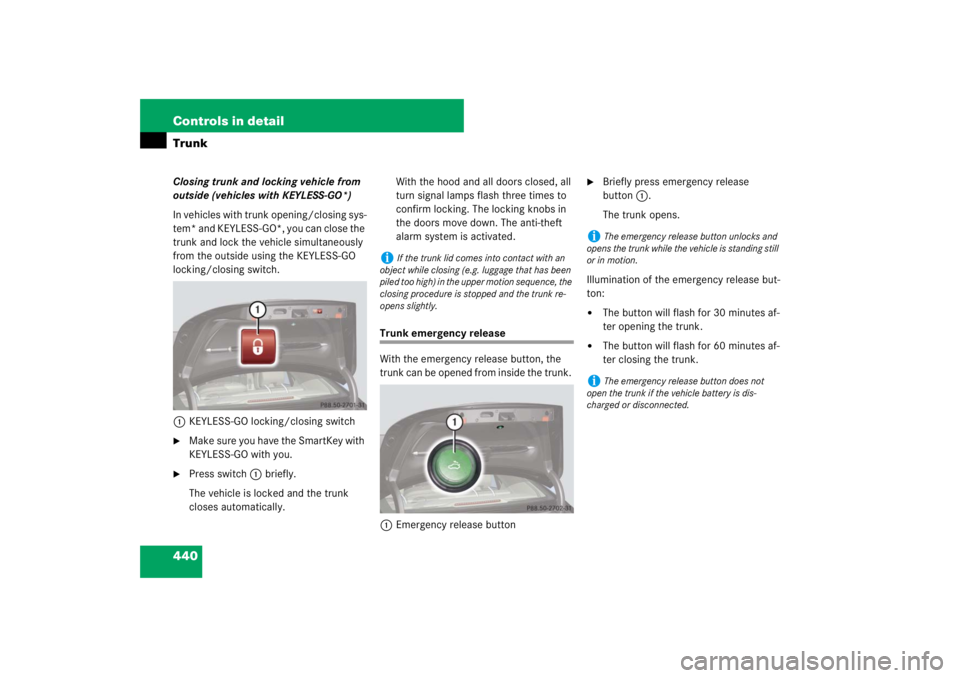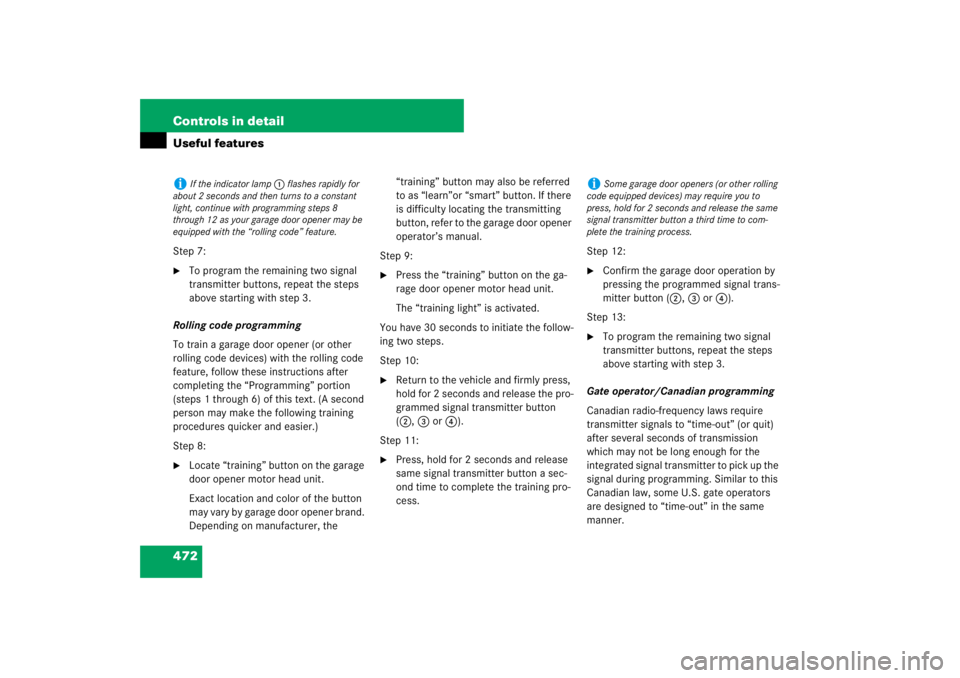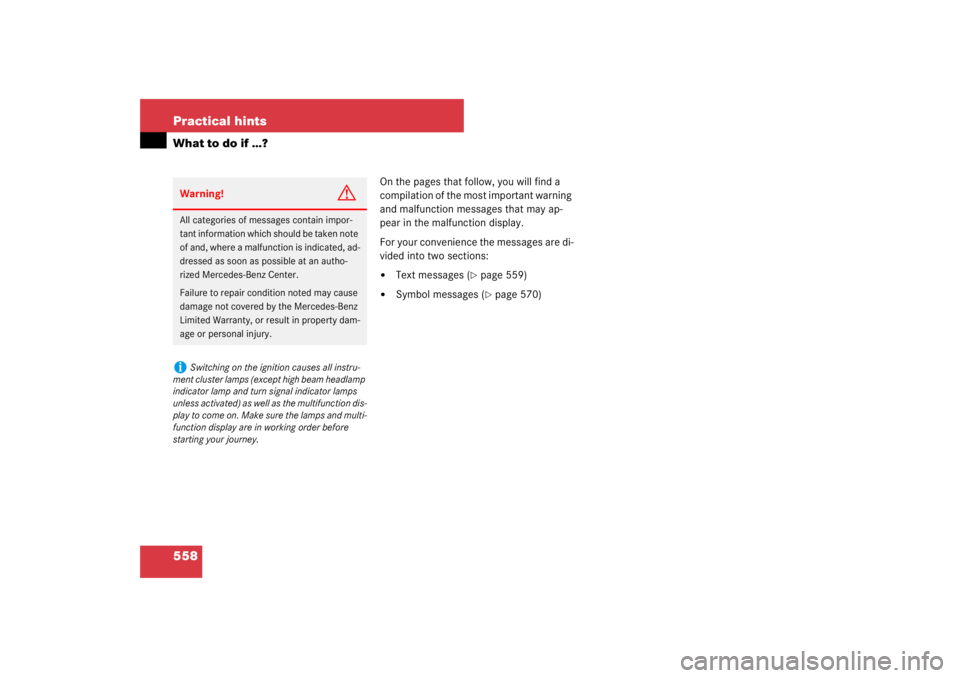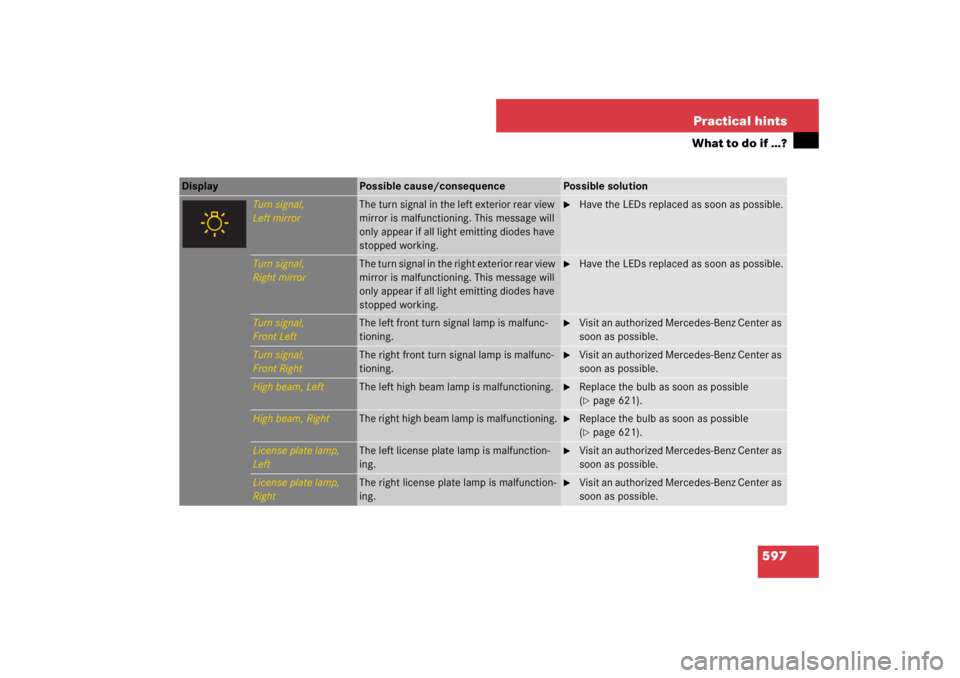Page 441 of 705

440 Controls in detailTrunkClosing trunk and locking vehicle from
outside (vehicles with KEYLESS-GO*)
In vehicles with trunk opening/closing sys-
tem* and KEYLESS-GO*, you can close the
trunk and lock the vehicle simultaneously
from the outside using the KEYLESS-GO
locking/closing switch.
1KEYLESS-GO locking/closing switch�
Make sure you have the SmartKey with
KEYLESS-GO with you.
�
Press switch1 briefly.
The vehicle is locked and the trunk
closes automatically. With the hood and all doors closed, all
turn signal lamps flash three times to
confirm locking. The locking knobs in
the doors move down. The anti-theft
alarm system is activated.
Trunk emergency release
With the emergency release button, the
trunk can be opened from inside the trunk.
1Emergency release button
�
Briefly press emergency release
button1.
The trunk opens.
Illumination of the emergency release but-
ton:
�
The button will flash for 30 minutes af-
ter opening the trunk.
�
The button will flash for 60 minutes af-
ter closing the trunk.
i
If the trunk lid comes into contact with an
object while closing (e.g. luggage that has been
piled too high) in the upper motion sequence, the
closing procedure is stopped and the trunk re-
opens slightly.
i
The emergency release button unlocks and
opens the trunk while the vehicle is standing still
or in motion.
i
The emergency release button does not
open the trunk if the vehicle battery is dis-
charged or disconnected.
Page 473 of 705

472 Controls in detailUseful featuresStep 7:�
To program the remaining two signal
transmitter buttons, repeat the steps
above starting with step 3.
Rolling code programming
To train a garage door opener (or other
rolling code devices) with the rolling code
feature, follow these instructions after
completing the “Programming” portion
(steps 1 through 6) of this text. (A second
person may make the following training
procedures quicker and easier.)
Step 8:
�
Locate “training” button on the garage
door opener motor head unit.
Exact location and color of the button
may vary by garage door opener brand.
Depending on manufacturer, the “training” button may also be referred
to as “learn”or “smart” button. If there
is difficulty locating the transmitting
button, refer to the garage door opener
operator’s manual.
Step 9:
�
Press the “training” button on the ga-
rage door opener motor head unit.
The “training light” is activated.
You have 30 seconds to initiate the follow-
ing two steps.
Step 10:
�
Return to the vehicle and firmly press,
hold for 2 seconds and release the pro-
grammed signal transmitter button
(2, 3 or4).
Step 11:
�
Press, hold for 2 seconds and release
same signal transmitter button a sec-
ond time to complete the training pro-
cess.Step 12:
�
Confirm the garage door operation by
pressing the programmed signal trans-
mitter button (2, 3 or4).
Step 13:
�
To program the remaining two signal
transmitter buttons, repeat the steps
above starting with step 3.
Gate operator/Canadian programming
Canadian radio-frequency laws require
transmitter signals to “time-out” (or quit)
after several seconds of transmission
which may not be long enough for the
integrated signal transmitter to pick up the
signal during programming. Similar to this
Canadian law, some U.S. gate operators
are designed to “time-out” in the same
manner.
i
If the indicator lamp1 flashes rapidly for
about 2 seconds and then turns to a constant
light, continue with programming steps 8
through 12 as your garage door opener may be
equipped with the “rolling code” feature.
i
Some garage door openers (or other rolling
code equipped devices) may require you to
press, hold for 2 seconds and release the same
signal transmitter button a third time to com-
plete the training process.
Page 538 of 705

537 Operation
Vehicle care
Ornamental moldings
For regular cleaning and care of ornamen-
tal moldings, use a damp cloth.Headlamps, tail lamps, side markers,
turn signal lenses
�
Use a mild car wash detergent, such as
Mercedes-Benz approved Car
Shampoo, with plenty of water.Cleaning the DISTRONIC Plus* system
sensor cover
1DISTRONIC Plus system sensor cover
�
Switch off the ignition (
�page 315).
�
Use a mild car wash detergent, such as
Mercedes-Benz approved Car
Shampoo, with plenty of water and a
non-scratching cloth to clean sensor
cover1.
!
Do not use chrome cleaner on ornamental
moldings. Although ornamental moldings may
have chrome appearance, they could be made of
anodized aluminum that will be damaged when
cleaned with chrome cleaner. Instead, use a
damp cloth to clean those ornamental moldings.
For very dirty ornamental moldings of which you
are sure are chrome-plated, use a chrome clean-
er. If in doubt whether an ornamental molding is
chrome-plated, contact an authorized
Mercedes-Benz Center.
!
Only use window cleaning solutions that are
suitable for plastic lamp lenses. Window clean-
ing solutions which are not suitable may damage
the plastic lamp lenses of the headlamps. There-
fore, do not use abrasives, solvents or cleaners
that contain solvents.
Never apply strong force and only use a soft,
non-scratching cloth when cleaning the lenses.
Do not attempt to wipe dirty lenses with a dry
cloth or sponge.
Otherwise you may scratch or damage the lens
surface.
!
To prevent scratches or damage, never ap-
ply strong force and only use a soft, non-scratch-
ing cloth when cleaning the sensor cover1. Do
not attempt to wipe dirty sensors with a dry cloth
or sponge.
Page 559 of 705

558 Practical hintsWhat to do if …?
On the pages that follow, you will find a
compilation of the most important warning
and malfunction messages that may ap-
pear in the malfunction display.
For your convenience the messages are di-
vided into two sections:�
Text messages (
�page 559)
�
Symbol messages (
�page 570)
Warning!
G
All categories of messages contain impor-
tant information which should be taken note
of and, where a malfunction is indicated, ad-
dressed as soon as possible at an autho-
rized Mercedes-Benz Center.
Failure to repair condition noted may cause
damage not covered by the Mercedes-Benz
Limited Warranty, or result in property dam-
age or personal injury.i
Switching on the ignition causes all instru-
ment cluster lamps (except high beam headlamp
indicator lamp and turn signal indicator lamps
unless activated) as well as the multifunction dis-
play to come on. Make sure the lamps and multi-
function display are in working order before
starting your journey.
Page 597 of 705

596 Practical hintsWhat to do if …?Display
Possible cause/consequence
Possible solution
Low beam,
Right
The right low beam lamp is malfunctioning.
�
Visit an authorized Mercedes-Benz Center as
soon as possible.
Active headlamps
inoperative
The active headlamps are malfunctioning.
�
Visit an authorized Mercedes-Benz Center as
soon as possible.
AUTO lamps
inoperative
The light sensor is malfunctioning. Daytime
driving lamps are switched on.
�
Visit an authorized Mercedes-Benz Center as
soon as possible.
Turn signal,
Rear Left
The left rear turn signal lamp is malfunction-
ing.
�
Visit an authorized Mercedes-Benz Center as
soon as possible.
Turn signal,
Rear Left
Substitute bulb on
The left rear turn signal lamp is malfunction-
ing. A substitute bulb is being used.
�
Visit an authorized Mercedes-Benz Center as
soon as possible.
Turn signal,
Rear Right
The right rear turn signal lamp is malfunc-
tioning.
�
Visit an authorized Mercedes-Benz Center as
soon as possible.
Turn signal,
Rear Right
Substitute bulb on
The right rear turn signal lamp is malfunc-
tioning. A substitute bulb is being used.
�
Visit an authorized Mercedes-Benz Center as
soon as possible.
Page 598 of 705

597 Practical hints
What to do if …?
Display
Possible cause/consequence
Possible solution
Turn signal,
Left mirror
The turn signal in the left exterior rear view
mirror is malfunctioning. This message will
only appear if all light emitting diodes have
stopped working.
�
Have the LEDs replaced as soon as possible.
Turn signal,
Right mirror
The turn signal in the right exterior rear view
mirror is malfunctioning. This message will
only appear if all light emitting diodes have
stopped working.
�
Have the LEDs replaced as soon as possible.
Turn signal,
Front Left
The left front turn signal lamp is malfunc-
tioning.
�
Visit an authorized Mercedes-Benz Center as
soon as possible.
Turn signal,
Front Right
The right front turn signal lamp is malfunc-
tioning.
�
Visit an authorized Mercedes-Benz Center as
soon as possible.
High beam, Left
The left high beam lamp is malfunctioning.
�
Replace the bulb as soon as possible
(�page 621).
High beam, Right
The right high beam lamp is malfunctioning.
�
Replace the bulb as soon as possible
(�page 621).
License plate lamp,
Left
The left license plate lamp is malfunction-
ing.
�
Visit an authorized Mercedes-Benz Center as
soon as possible.
License plate lamp,
Right
The right license plate lamp is malfunction-
ing.
�
Visit an authorized Mercedes-Benz Center as
soon as possible.
Page 622 of 705
621 Practical hints
Replacing bulbs
�Replacing bulbs
Safe vehicle operation depends on proper
exterior lighting and signaling. It is there-
fore essential that all bulbs and lamp as-
semblies are in good working order at all
times.
Correct headlamp adjustment is extremely
important. Have headlamps checked and
readjusted at regular intervals and when a
bulb has been replaced. See an authorized
Mercedes-Benz Center for headlamp ad-
justment.
i
If the headlamps or front fog lamps are
fogged up on the inside as a result of high humid-
ity, driving the vehicle a distance with the lights
on should clear up the fogging.
i
Substitute bulbs will be brought into use
when the following lamps malfunction:
�
Brake lamps
�
Rear fog lamps
�
Front parking lamps
�
Tail lamps
�
Turn signal lamps
Observe the messages in the multifunction dis-
play (�page 557).
Page 623 of 705
622 Practical hintsReplacing bulbsBulbs Front lamps Rear lamps
Lamp
Type
1
Bi-Xenon headlamp:
Low and high beam
1
1Bi-Xenon headlamps: Low beam and high beam
use the same D1S-35W lamp. Do not replace the
Bi-Xenon bulbs yourself. Contact an authorized
Mercedes-Benz Center.
D1S-35 W
2
Additional turn signal
lamp
LED
3
Parking and standing
lamp
W5W
4
Side marker lamp
W5W
5
Bi-Xenon headlamp:
High beam flasher lamp
H7-55 W
IR emitter* (for Night
View Assist*)
H11-55 W
6
Corner-illuminating
lamp
H7-55 W
7
Fog lamp
H11-55 W
8
Turn signal lamp
PY 24 W
Lamp
Type
9
High mounted brake
lamp
LED
a
Turn signal lamp
HiP 16 W
b
Brake lamp/tail lamp
and standing lamp
LED
c
License plate lamp
W5W
d
Backup lamp
HiP 16 W
e
Side marker lamp
LED
f
Rear fog lamp (driver’s
side only)
HiP 16 W